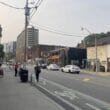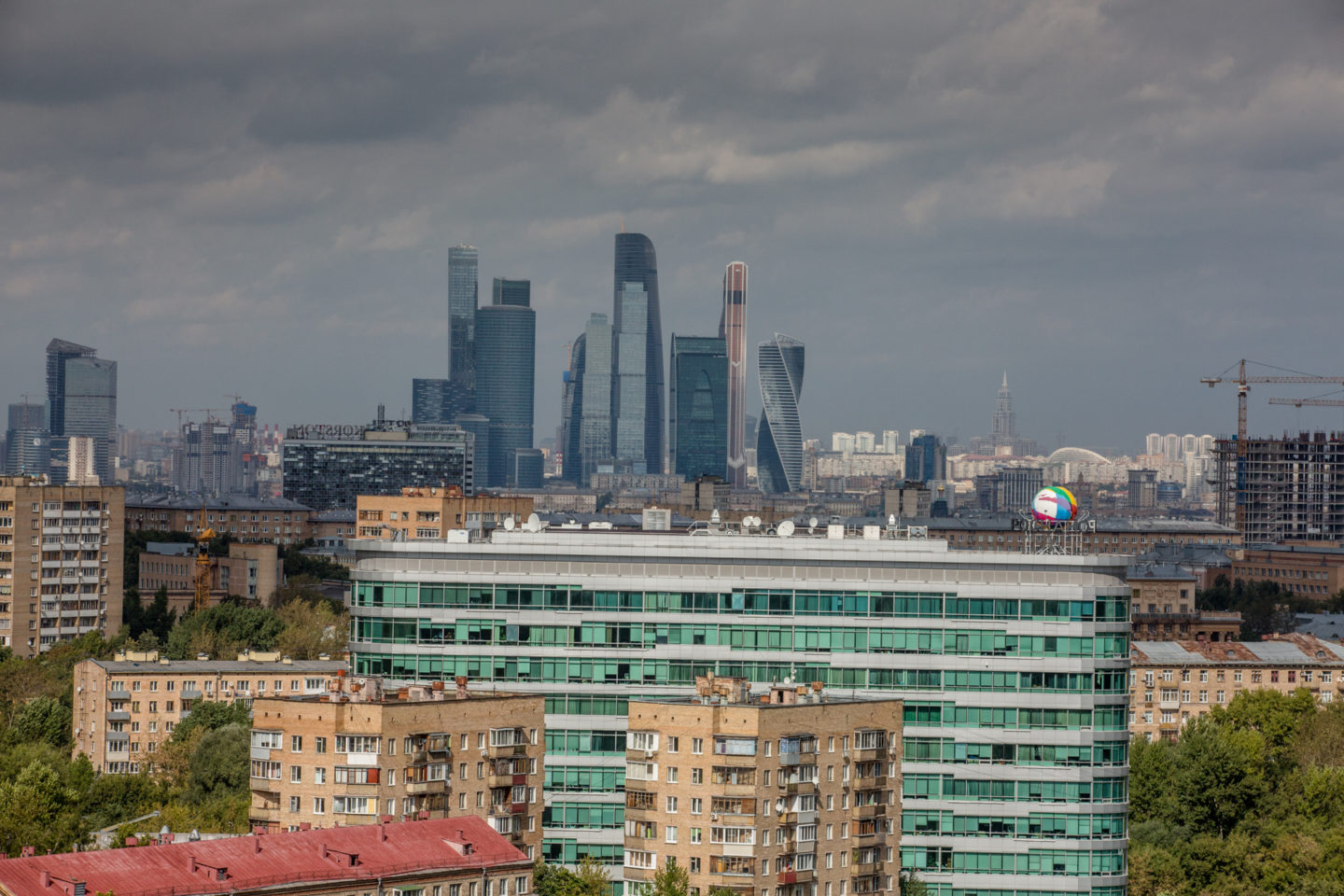In September 2017, Chris Leslie, award winning photographer and filmmaker, and Dr Jonathan Charley, from the Department of Architecture, University of Strathclyde, visited Moscow to report on one of the largest urban migration programmes in history.
It is unseasonably hot in the Butirsky district of northern Moscow. An old lady waves from the top floor of a 1960s five-storey concrete apartment block. Prefabricated in their tens of thousands, flats like these were once an icon of Soviet modernity and heralded as the solution to the post Second World War housing crisis.
Over the next few years the majority of them will be erased as part of the Moscow Government’s controversial plan to demolish four and half thousand apartment blocks, many of which sit on valuable real estate.
The scale of what the authorities have called a ‘renovation programme’ is extraordinary and will result in the relocation, in some cases forced, of nearly two million people.
From her window, the old lady can see the footprints of recently demolished homes. The neighbouring flats are already empty and forlorn, and hers is next for the bulldozer.
Although she won’t be thrown out on the street and will be offered alternative accommodation, the insecurity surrounding the demolition programme is bad for everyone, and particularly the elderly for whom such a move can be fatally traumatic.
The situation isn’t helped by news that a brand new multi-storey tower behind her home was evacuated after only a year because of serious construction faults.
Neighbourhoods like these are a world apart from the downtown bling of contemporary Moscow, and light years away from the luxury dachas and penthouse flats enjoyed by the super rich, for whom the revolutionary rhetoric of workers’ power and social equality seems like a nightmare from a parallel universe.
One of the most remarkable features of the last twenty-five years has been the speed with which the legacy of 1917 has been disowned. Within days of the defeat of the 1991 putsch by Communist Party hardliners, the Tsarist Eagle fluttered from the parliament flagpole and the city began its descent into wild gangster capitalism. At the time it seemed as if a demented three-way marriage had taken place between a Yakuza banker, a 19th century British slave trader and a gun toting Chicago bootlegger.
Casinos and hard currency shops mushroomed across Moscow and, for the first time in seventy years, a real estate market emerged.
State housing was privatised and landed property was restored. Factories closed, subsidies were withdrawn and single industry towns – once decorated in crimson flags -were abandoned.
The safety net that for generations had guaranteed citizens basic housing, education and health care services, began to disintegrate.
A new word appeared in the vocabulary, ‘Bezdomniyi’ (homeless), the key index along with unemployment of the rapidly deepening social inequality that accelerated as the 1990s unfolded.
Today, it continues to get worse. A widely circulated Credit Suisse report claimed that as of 2015, Russia had the worst level of wealth inequality in the world.
Building Potemkin Villages To Camouflage Reality
Homelessness reached a high point in the late 1990s and remains a major problem. In 2015, an article in the Moscow Times claimed that there were approximately 17,000 homeless in the city. But with only ten municipal hostels providing 1500 beds, the social infrastructure needed to support the homeless is clearly inadequate.
The demographic profile of those labelled BOMZh, Bez Opredelenovo Zhilishye (more or less equivalent to ‘no fixed abode’), is no different in Moscow than in any other city.
Heroin addiction, alcoholism, and mental health issues abound and ensure that fragile social services are stretched to the limit.
It is a critical situation, further compounded by the large numbers of families and individuals fleeing poverty in provincial towns who migrate to the city in pursuit of a better life. Officially the current population of Moscow stands at thirteen million but if the large numbers of illegal immigrants and others living on the edge are included, it is reckoned to be considerably higher.
The majority of these highly vulnerable people live out on the periphery or beyond in the ‘New Moscow’, in neighbourhoods that tourists seldom see – out of sight and out of mind.
Muscovite politicians, like their counterparts elsewhere, don’t want visible signs of social inequality spoiling the view of the freshly scrubbed historical monuments that punctuate tourist bus routes.
Cities these days have to be ‘instagram-facebook’ ready – a polished, sophisticated, and ‘ready for business’ metropolis does not have street urchins, beggars and tramps.
Accordingly, as Moscow gears up for its showcase event of 2018 – the World Cup – the police are on high alert for possible ‘deviants’.
In this sweep, they were aided by a recently convicted gang of zealots who roved Moscow’s streets murdering the homeless. For such a grotesque and utterly fascist act they were sentenced to just nine years.
Deportation and the Violation of the Constitution
Homelessness, by definition, means having nowhere to live. But there is another allied sense that refers to the emotional and psychological consequences of being forcibly uprooted from your home and community.
It is exactly this sort of traumatic experience that has enveloped the lives of the many Moscow citizens who face being relocated against their will. The reasons given by the authorities for the demolition programme is that the five-storey apartment blocks are simply beyond repair.
In contrast, architects and engineers insist that with research and imagination, the blocks can be given a new lease of life.
However, they have been largely ignored and the Moscow Municipal government has forged ahead and drawn up a plan indicating all of the blocks to be demolished. It also shows the locations of the new developer built towers where residents, who will not have a choice, will be rehoused.
The situation has left homeowners like Anastasia Yanchikova both upset and bewildered.
“I feel safe here. I can see my children in the yard and we leave our bikes at the bottom of the stairs. I have a right to stay in my neighbourhood. I want to choose myself where to live, in what kind of building, place and so on. I feel deceived.
“Two years ago politicians obliged me to pay into a capital repair fund for the overhaul of our housing that was scheduled to be completed by 2030. They told us that the houses are strong. And then this year the same politicians tell us that our homes are in an emergency condition and need to be demolished?”
Anastasia and her family find themselves in this predicament because the majority of her neighbours support the renovation programme. In June 2017, the Moscow Duma passed legislation that allowed residents of a block to vote as to whether their homes should be demolished.
If two-thirds are in favour then the block is levelled. This means that remaining residents who voted ‘no’, like Anastasia, will face eviction. One of the consequences of the privatisation of the state housing sector was that individuals became responsible for the repair and maintenance of their apartments.
For the poor and unemployed who are unable to invest in their homes, the offer of a new flat seems a great option.
Reports of poor construction and uncertainty over where people might be rehoused are countered by Major Sobyanin’s propaganda team – which has been working overtime, building show flats and launching seductive multi-media campaigns that depict the happy life awaiting residents in new estates.
Rumours of irregularities and illegal practice underpinning the development process are widespread and the clandestine and dubious way the demolition campaign is being conducted has provoked fury. Thousands of people carrying banners emblazoned with the word ‘deportation’, have marched in the streets to demonstrate against what they see as a thinly disguised exercise in property speculation.
Nikolai Kanchov, an activist who stood for election to the municipal government for the opposition Yabloko party, maintains that the eviction of families from their homes both violates the constitution and their rights as citizens:
“In a nutshell, the demolition program has deprived me of my right to a home,” Kanchov says. “It has made me worried and uncertain about the future. I can’t be sure that my family and I won’t be forced out of our home tomorrow by the will of some tricky bureaucrat, greedy for money.
“I’m forced to study the legislation and collect testimony, write petitions, claims and appeals, gather signatures, all in order to protect my home. Instead of working and earning my living.”
With trillions of rubles – billions of pounds – being spent over a ten-year period, conspiracy theories are rife about covert land deals, pecuniary handshakes and foreign bank accounts.
What is beyond doubt, is that there are vast sums of money to be made through the sale of formerly collectively owned land to the private sector and by the construction of the tower blocks to which families will be decanted.
The Destruction of Memory and History
A major cause of residents’ anger and frustration is that many of the flats scheduled for demolition are not only structurally sound but situated in green neighbourhoods that have excellent transport links, social and cultural infrastructure.
Residents argue that their flats have been targeted because they are on land favoured by developers. Many families facing eviction have lived in the same flat and neighbourhood for decades.
The Metrogorodok district of eastern Moscow is a working class neighbourhood and old industrial area that was originally built for the builders of the Moscow metro system. The flats here are in need of repair, but they are still standing and bustling with activity.
An old lady accosts us and, having accused us of being Ukrainian bandits, and then western spies intent on showing how terrible life is in Russia, summarised briefly what we would hear from most interviewees.
“What do I think about the demolition programme? This is my home,” the woman said.
A short walk away lives Yulia Fedosova and her son Maxim. Her family has lived in the area for generations and her immediate relatives live within easy walking distance.
She was born in the flat and her father was also raised there. She can look down from her balcony and see her son playing in green parkland where residents planted flowers and fruit trees.
Her anger and frustration is profound and she is aghast at the “insensitive and scandalous” way that she and her family have been treated.
Fedosova tells us she would rather leave Moscow altogether than face a future marooned in a tower block. She has one word to describe the attitude of the authorities – “bestial” – and summarises the underlying contradiction of the proposed ‘renovation programme’ in equally blunt terms.
“How is it possible to take people and move them to where the authorities want, in high-rise pens with just a patch of greenery in the middle?” Fedosova says.
“You cannot treat Moscow and its inhabitants like this. We are not here for the short-term. The city should be built for the comfort of its residents and not developed for the sake of maximising profits at all costs.”
It is unlikely that people like Yulia will become destitute and forced to live on the streets, or as some do, underground in the sewer system huddled next to heating pipes. Yes, repairs are needed, the roof probably needs replacing and her kitchen is small.
But what is really at stake for people like her is the destruction of the quality of everyday life, those unquantifiable things that bureaucrats cannot understand and speculators ignore.
In the neighbourhoods that face demolition, children are safe. Many of these areas are also environmentally diverse and designed at a human scale.
Perhaps most important of all for long-term residents, is that they are rich in irreplaceable memories.
Trauma and Betrayal
Built in the mid 1950s the Nishegorodski district is another leafy, well-serviced area. Shops, health clinics, schools, kindergartens, and transport links are all accessible by foot within minutes.
Like the Fedosova’s block, the apartments here are also five storeys high but brick built. They are robust and well constructed and are linked together by an innovative district heating system.
Here we meet the fiercely proud Vladimir Komarov, a retired government employee who shows us around his flat, and the memorabilia of three generations of his family who once lived there.
His grandmother lies in the graveyard next door and he is visibly distraught as he explains how after a lifetime of serving the state he finds himself in such a situation.
On receipt of news he was going to be evicted, he suffered a stroke and spent two months in hospital. His sense of betrayal was deeply moving and as we left he begged us for help.
“Fraud”, “scandal” and “Vney Zakona” (outside of the law) are just some of the expressions used by other residents to describe their feelings.
Pensioners Olga and Vassily Leskova live in the area and are in a similar predicament to the Komarovs. Their apartment block is also in rude health and is a palimpsest of their family history and working lives as a Sister and Professor of Immunology.
For them, home is not just the sum total of the interior of the flat, but extends to the whole neighbourhood and networks of friends and acquaintances, built up over decades, soon to be destroyed when the demolition goes ahead.
The situation has turned very sour for the Leskovas. Neighbours who voted differently have fallen out with each other. In some blocks there has been violence between residents. Like many others they find it incomprehensible as to how they are being treated in such a manner. Their prospects are not good.
Going to court to challenge rulings is almost pointless since the judicial system is stacked against them. I ask Vassily if he has any words to describe what he thinks about the whole process. He falls silent for a few seconds and then replies:
“Chistiye Obman (pure deception),” he says,
The authorities are offering compensation as an alternative to relocation but it is based on their estimation of the flat’s value. As the Leskovas point out, the sums offered are laughable.
Besides which, you cannot put a price on sixty years of precious history, and so, at the age of seventy, they face the option of joining the ranks of the street homeless, moving to another town, or agreeing to a flat in what Vassily dismissively calls a “termite hill”.
Similar sentiments are echoed by a neighbour Tatjana Buyanova, who also faces eviction. “My apartment is everything that I hold dear – and now I’m losing it,” she says.
The inclusion of her block in the demolition programme after the majority of her neighbours opted in favour, has left her profoundly depressed to the point where she has considered emigrating.
Despite her best efforts to challenge the authorities, they have refused to talk to her. In an ominous turn of phrase, she was told that “dissenters must submit” by one official from the town council.
Protest and Resistance
Meeting families like the Fedosovas, Leskovas and Komarovs seemed a little like attending a wake, and indeed what they are being forced to endure is tantamount to a kind of bereavement.
Yes, they are losing their home, but also a sense of belonging, and identity, while facing the disintegration of the rich tapestry of social relationships that can only be built up over time. In short, it is the end of a whole way of life.
What’s happening in Moscow – politically sanctioned property speculation, masquerading as socially beneficial urban renewal – is hardly unique to the city. It is a feature of urbanisation around the world. But what is perhaps different is the scale and rapidity with which it is being conducted.
Given the strength of the Russian state it is difficult to avoid being pessimistic but there are also reasons for optimism. There are signs of resistance.
The on-line protest group Muscovites Against Demolition now has over twenty eight thousand members. Small numbers perhaps but a significant event in a city in which political demonstrations and criticisms of the ruling elite remain precarious activities.
What is particularly noticeable is that many of those demonstrating have never been to a protest before. Far from seasoned militants they number former supporters of Putin’s One-Russia Party – pensioners, single parents and ordinary workers who have collectively found a voice.
As in rent strikes and other historical struggles over housing, women are at the forefront of the movement. Streets protests, petitions, guerilla art projects, lobbying politicians, and simply refusing to move are just some of the tactics being employed.
The irony that last year marked the one hundredth anniversary of the 1917 Revolution is not lost on people. Quite by accident, in his determination to pursue the demolition programme, Sobyanin, a friend of Putin, has mobilised citizens against the authorities. As the activist Pavel Novikov commented:
“One of the strange things about the protest movement is that it has awakened in Muscovites a sense of having civil rights and of their ability to oppose the state’s interference into their private lives.”
You can find our more about Jonathan Charley on his website. You can find our more about Chris Leslie at www.chrisleslie.com














